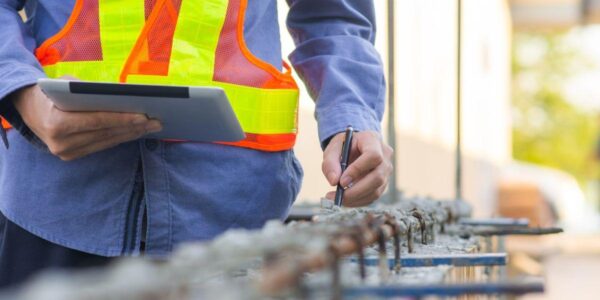
Conducting an onsite safety inspection is an integral part of a quality construction safety program, but if you don’t have a background in safety, it’s hard to know what to even look at, let alone what is considered unsafe.
Your trade also factors into the equation, as there are likely hazards that are specific to the tasks your workers complete. A welder is going to face very different hazards than a carpenter.
At SafetyHQ, we work with hundreds of contractors, spanning a wide variety of trades. Having designed their electronic inspection forms for them means we have seen thousands of inspection points.
On a large scale, the number of items to inspect is pretty overwhelming; however, there are some general areas that show up on every form. Below, we have captured the most common ones so you can begin with them and add in more specific inspection points as you gain experience.

10 Areas You Should Inspect While Onsite
1. Emergency Planning
If there were to be an incident on your job site, are you prepared? Some items to consider are:
- having a fully stocked first aid kit
- someone trained in first aid onsite
- a fully charged fire extinguisher nearby
- an emergency escape route
- a designated meeting spot
Some states and local municipalities also require you to have certain signage posted on site. This includes posters such as overhead work and emergency contacts.
You should also check with the general contractor as they may want you to produce information such as a written Safety Manual. Making sure these items are available to your workers and that they know where to find them will ensure incidents are dealt with properly if one does occur.
2. Personal Protective Equipment (PPE)
You need to make sure all of your workers have access to and are wearing personal protective equipment specific to the task they are working on.
This is going to differ significantly depending on your trade but should include, at a minimum, protection for:
- Hands
- Eyes
- Hearing
- Respiratory
- Feet
- and proper clothing on the body
3. Material
It is important to consider what materials you are working with and how they impact the safety of your workers.
OSHA requires you to have a Safety Data Sheet available for every material your workers come in contact with. This is especially important when working with hazardous chemicals.
How material is stacked and stored should be checked as well. Items that could fall over easily shouldn’t be stacked high, some combustible materials need to be stored in cages, and nothing should be near building perimeters.
Finally, you need to look at how material is being moved around the jobsite. Workers should be using aids such as wheelbarrows whenever possible and proper lifting techniques when not.
4. Housekeeping
A clean job site is not only safer because there is less of a chance your workers will trip, but it also makes it easier to spot hazards.
Check all aisles, passageways, stairs, and landings to make sure there is adequate space to move about safely.
Work areas should be cleared of debris at multiple points throughout the day.
5. Access and Egress
Inspect how your workers are getting in and out of the site, especially if they are required to climb ladders or stairs.
Stairs should have proper rails and landings, and all openings should be protected and clearly marked.
Ladders need to be in safe working condition, set up properly, and used correctly.
6. Hand, Pneumatic and Power Tools
Tools need to be inspected to make sure they are in good working condition and that their safety features, such as guards, are in place.
You should also try and see your workers using the tools to ensure they are complying to proper and safe techniques.
Additional PPE is often required when using specific tools so also take a look at what they are wearing.
7. Electrical
Electricity is a hazard on every job site, for every worker and so it should be included in your inspection.
Electricians, however, need a much more detailed level of inspection when it comes to hazards, which is why this item is also included as a trade-specific hazard below.
A general inspection of electrical hazards should include making sure all extension cords and tools are protected by a ground-fault circuit interrupter (GFCI), that cords are not frayed or spliced, and that electrical equipment is away from groundwater.
Also, take note of any overhead wires and make sure workers and equipment are staying well clear of them.
8. Large Machines
Most job sites are not complete without at least one large machine, often many.
These machines are usually used to lift and transport materials or dirt and sometimes to even complete work out of. This includes aerial lifts, forklifts, cranes, backhoes, etc.
Each of these machines needs to be operated by someone who is certified to do so and who conducts a separate daily inspection on every machine they operate.
9. Other Factors
You can do everything right, and then something unexpected happens, and suddenly, your job site is no longer safe.
If you work primarily outdoors, the weather can have an effect on your safety. You need to consider and check that workers have taken precautions against the elements, including extreme hot and cold, rain, wind, ice, snow, and hail.
You should also consider other trades that may be onsite and may create hazards for your workers simply by doing their job, especially if they are working in close proximity.
Finally, traffic and the general public can cause hazards to your workers and also need to be protected. Taking a few measures to look at the bigger picture is only going to protect your workers more.
10. Trade Specific Hazards
There is no possible way for us to capture every single potential hazard on a job site.
Please take time to write down common hazards specific to your trade.
This may include but isn’t limited to:
- falls from heights/fall protection
- compressed air or gas
- confined spaces
- electricity
- open flame
- scaffolding
- silica protection
One of the best ways to gather a realistic view of what goes on at your job sites is to show up, especially unexpectedly.
If you conduct and document a safety inspection while you are there, you may be able to find and correct hazards before they turn into an incident and can even protect your company from potential citations if an incident occurs.
Next Level Stuff
If you skip the paper inspection and move right to doing your inspections in a safety management system like SafetyHQ, it is the same amount of work (actually even less) and provides more benefits to your company.
SafetyHQ collects all the data from your inspections in real time and allows you to analyze and graph the results. You can easily see where your crews are struggling to comply and where they are succeeding.
You can also review the results by employee so you know who needs more training and who deserves a raise (or at least a high five).
If you want to see some of the cool analytics SafetyHQ provides, you can book a demo.
If you want to start on paper first, we have taken all the information above (and more) and put it into a checklist format that you can print and start using today. Download this free resource below.
Otherwise, you may find these articles helpful:
5 Simple Tasks to Improve Your Construction Safety Program
How Much Does SafetyHQ Cost
What is a Job Site Hazard Assessment (Definition and Usage)
Share Article
Keep on current news in the construction industry. Subscribe to free eNews!



